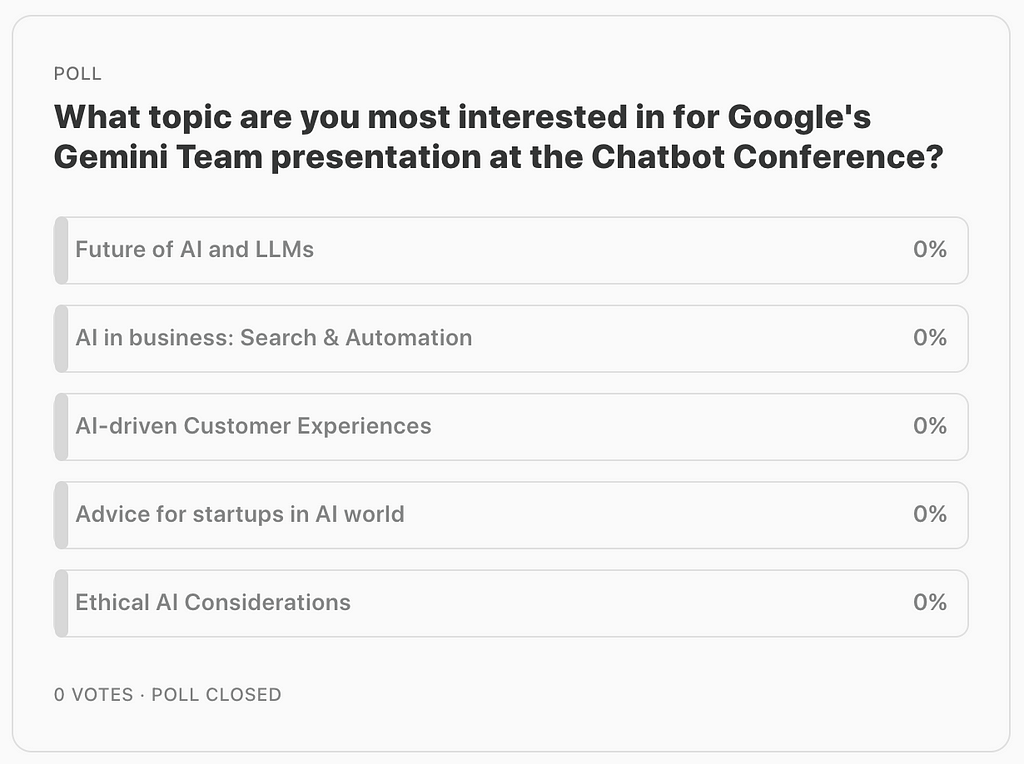How to give custom instructions to have a real-time conversation between chatbots sharing the same contexte, like this : Speaking Avatars Story | Episode 1: AI vs Human
submitted by /u/yaaatmssss
[link] [comments]
How to give custom instructions to have a real-time conversation between chatbots sharing the same contexte, like this : Speaking Avatars Story | Episode 1: AI vs Human
submitted by /u/yaaatmssss
[link] [comments]
So I wanted to ask like suppose we have trained the chatbot on a particular set of documents , then I ask some query to that chatbot and it returns me with the most relevant text chunk from the vector db , but suppose after that I ask the chatbot some non relevant but relevant to the conversation question like “can you explain your response in much better way?” , then the chatbot does not gives response. How do we handle such questions ?
submitted by /u/HarryBarryGUY
[link] [comments]
Yodayo: Great for hentai fans to chat with anime characters
Chai: It seems like only supports mobile phone apps
Haven chat: Characters have strong personalities
FantasyGF: Realistic NSFW AI girlfriend platforms
Juicy AI: 7000+ characters. Long and descriptive contents
Dopple.ai: Another Free NSFW AI chatbots
Gptgirlfriend: 25 000+ NSFW Characters including anime and realistic ones
Nextpart.ai: Supports voice chat, scene generation, and crypto payments
Privee AI: Different models available 70b to gpt4. Images Generation. Simple and advanced creation mode.
SpicyChat : Free, but need to queue. You can pay to skip the queue. No generated images. Around 2000 words of memory
CandyAI : Good quality NSFW photos but you need to pay. Average level of chat.
MuahAI : Text+Image+phone call (US number only). Free for chatting, payment for image and phone calls
submitted by /u/all-purposetights25
[link] [comments]
https://go.matchmasters.io/l/send/66930b13f498f4b37f38c719?aid=16&sn=1 Send me this sticker please!
submitted by /u/Porchmonkiee
[link] [comments]
I want to try an ensemble cast type thing. I want to have multiple characters. Is there something like this? You can technically do it with character.ai, but it doesn’t pull any info from the bio.
Is there a program where I can do something like this? I am indifferent to if it is nsfw or not. I want to, say, go sailing with a first mate, a talking wise owl as a pet, etc. Maybe 2-3 distinct characters in the story, each with their own bio. Or maybe a war; 2-3 ‘good guys’ and 2-3 ‘bad guys’? Does anything like this exist/what is the best platform for this?
submitted by /u/First_Macaroon_9281
[link] [comments]
Hey guys! Recently I’ve been having some amazing story based chats with different character bots. Some NSFW others pretty alright story bases chats. Anyways most of it reads like fan fiction.
So If I say took a transcript of a conversation and changed names of recognizable characters, rewrote it enough to be readable in a first person format like twilight or Harry potter, and sent that transcript off to a publisher to be put up for like 5 bucks on Amazon or other marketplaces.
Maybe even published, as a lot of major stores are publishing low level authors right now and putting it In their stores just trying to sell new books.
I guess my question is, what’s the possibility or what do you think the possibility is of me making money on this?
submitted by /u/JacenT98
[link] [comments]
Like many of you, I initially started my adventures with Character AI, then I subscribed to Crushon and was amazed at what it could do when the NSFW feature was introduced. But it didn’t last long, as C.ai began to show various limitations and the logic of the replies became strangely logical, always repeating the same words. The overall quality of the output, however, was plummeting, which I regretted. Then I came across Crushon, which also performed excellently. But with it came premium paid services. The experience of using the free version declined dramatically. Just as everyone was upgrading to the GPT4 model, I tried out the newly launched HeyrealAI and I was impressed with it. However, the use of dual models improves the user experience, but sometimes there are small bugs on the multi-language environment, but Heyreal’s excellent review and feedback mechanism is enough to resolve this difficulty. The user experience is outstanding.
submitted by /u/mintown994
[link] [comments]

Dear Chatbot Enthusiasts,
Ready for some exciting news?
We’ve got Google’s Gemini Team in our sights for the upcoming Chatbot Conference in San Francisco (Sept 24–26), and we need YOUR help to make it great! 🎉
To ensure we select the topics that matter most to you, we’d love your input.
We’ve prepared a quick poll to gather your preferences. You can also suggest a topic by replying to this email.
Poll Question: What topic interests you most for Google’s Gemini Team presentation?
You can take the POLL HERE or let us know in the comments.
We appreciate your insight and feedback.
Thank you for helping us create an event that pushes the boundaries of AI innovation.
Best regards,
Stefan
💡 If You Could Ask Googles AI Team Anything, What Would It Be? was originally published in Chatbots Life on Medium, where people are continuing the conversation by highlighting and responding to this story.